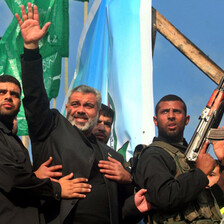The Electronic Intifada 13 June 2006
“The IDF is the most moral military in the world; there has never been - and there isn’t now - a policy of attacking civilians.”
— Prime Minister Ehud Olmert’s remarks at the start of the weekly Cabinet meeting, 11 June 2006. Communicated by the Prime Minister’s Media Adviser.
Stepping through the looking glass
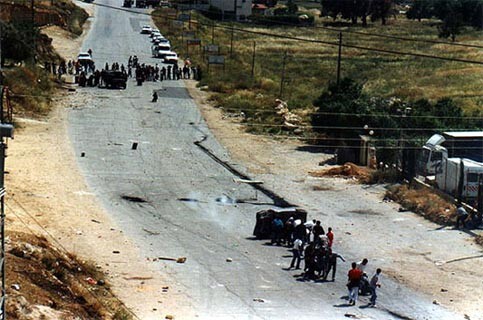
In the foreground, Palestinian youths carry off an injured friend to a waiting ambulance. Al-Nakba demonstrations, Ramallah, 14 May 1998. (Nigel Parry)
When I lived in Ramallah between 1994-1998, the era of the so-called peace process, I witnessed perhaps 30 clashes between young Palestinians and Israeli soldiers to very consciously document and photograph what transpired. I was sick to my stomach with reading media reports by foreign correspondents that characterized these events along the lines of:
Israeli soldiers and Palestinians clashed today on the outskirts of Ramallah. Two Palestinians were killed and four injured.
What was problematic about these reports was the utter lack of contextual information that let you know how a stone-throwing protest routinely ended up with dead Palestinian teenagers and children.
Bar the five days of the September 1996 Clashes, which saw an escalation from stones to guns after 5 Palestinians were shot dead at the beginning of the first day, none of the Palestinians at these 30 clashes were armed with anything other than stones and the very occasional Molotov cocktail. It was simpler in those days, unlike the speedy militarization of the Second Intifada, courtesy of Arafat’s Fatah movement. With the guns on only one side, the chilling context of power disparity was out there in plain sight.
Of the several Palestinians who I saw shot dead at these 30 clashes, not a single one of them was killed within any range that they could have hit an Israeli soldier with a stone. In the single clash where I witnessed an Israeli soldier grazed by a stone, the killing that took place happened much later. At no time was there any life-threatening situation that required these soldiers to behave any differently than riot police would behave in a more civilized country.
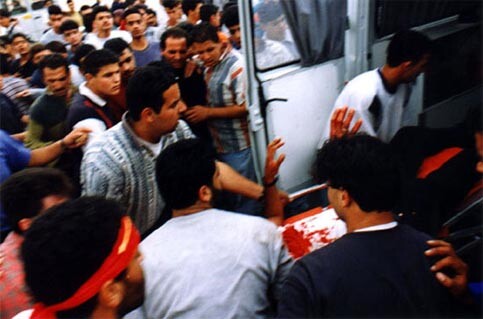
A young Palestinian with a head injury from a rubber-coated metal bullet. Al-Nakba demonstrations, Ramallah, 14 May 1998. (Nigel Parry)
At these clashes, the Israeli soldiers would do things that boggled the mind. They would trade curses with the young Palestinians, laughing and shouting with other soldiers. They would shoulder their rifles and throw stones at the Palestinians. They would make animal sounds, grunting and jumping around like monkeys, inciting the Palestinians to venture out of cover. The soldiers would use live ammunition and “less lethal” ammunition (such as rubber-coated metal bullets) simultaneously, thus negating the very reason that troops are issued with the “less lethal” munitions.
Out of nowhere, when the energy of the clashes seemed to be dissipating, a soldier would suddenly shoot a child or teenager, 100 meters away from them or more and in front of you. Next time you find yourself in an open space with no people around, see how far you can throw a stone. You’ll find it to be considerably less than 100 meters.
Let me be clear. The events I am describing, in the clashes where people died, were not the exception. They were the rule. And not one soldier was ever punished.
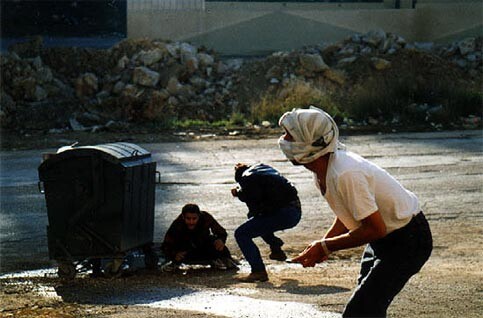
Palestinians take cover behind a metal dumpster as Israeli troops open fire. Abu Ghnaim clashes, Ramallah, 26 March 1997. (Nigel Parry)

After you see someone kill a child, you perceive humans very differently after that. We like to assume that when such a completely inexcusable event takes place that the deaths happened by some kind of “accident” or “error”.
“Crossfire” was perhaps Israel’s most successful lie at the onset of the Second Intifada, and no amount of statistics showing otherwise really seemed to penetrate our consciousness and make a difference.
It made no difference because inside we desperately want to believe that the murderers and serial killers of this world are aberrations, rare, that they are sick or somehow different. This conclusion is not possible when you witness a common, recurring pattern with your own eyes, across an entire army. At some point something gives way inside, and your fantasies about basic human decency crumble.
On the macro level, Israel has behaved with similar callousness as their soldiers do at clashes. One of the clearest examples from the current Intifada took place on 23 July 2002. Fourteen Palestinians, mostly women and children, were killed when an Israeli F-16 dropped a 1,000-kilogram bomb on an apartment building in the al-Daraj neighborhood of Gaza City, to assassinate Salah Shehadeh, then leader of Hamas’ military wing.
Massive civilian casualties were inevitable given the size of the bomb used and the crowded area on which it was dropped. A Ha’aretz journalist subsequently asked Maj. Gen. Dan Halutz, a key figure behind Israel’s assassination policy, whether he felt any remorse about the incident. After making a hollow statement of regret for the children killed and defending the policy, he stated:
“If you insist on wanting to know what I feel when I release a bomb, I will tell you. I feel a slight bump to the plane as a result of bomb’s release. A second later it passes, and that’s all. That is what I feel.”
Misinformation is a weapon of mass destruction
Whether long-range weapon or suicide bomb
A wicked mind is a weapon of mass destruction
Whether you’re Soaraway Sun or BBC One
Misinformation is a weapon of mass destruction— Lyrics from “Mass Destruction” by Faithless
Our blindness and wishful thinking that these things aren’t so are an intrinsic part of the system that kills. We are separated from these events by distance and depend on others to tell us what is going on.
The foreign journalists that theoretically exist to report to us the simple facts share these same flaws and make it even harder for themselves to get to the heart of the matter by living almost without exception in Israeli population areas.
As their even more remote editors relentlessly demand the “latest” information rather than insisting on the whole story, they can do no more than skip like stones on the shallow surface of reality, a process as inevitable as knowing a 1,000 kilogram bomb dropped on an apartment building will kill civilians.
Those who slow down, dig deeper, and report the obvious patterns find their stories spiked, their editors’ mailboxes filled with angry letters from people who never read a word of their story and, if needed to finish them off, whispered accusations that they are motivated by a hatred of Jews.

Original AFP caption: A handout photograph released by the Israeli army shows an Israeli navy vessel shelling a beach in the northern Gaza Strip on 09 June 2006. The killing of eight Palestinians at a seaside picnic in Gaza has left Israel’s embarrassed government scrambling to control the damage ahead of Prime Minister Ehud Olmert’s first trip to Europe. (IDF/File)
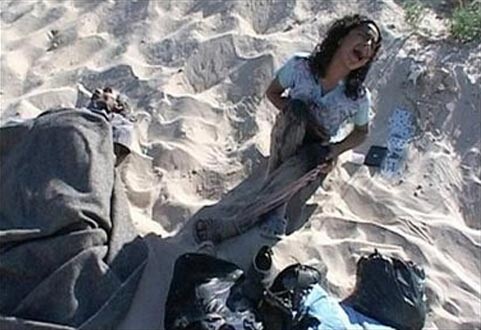
This image taken from TV footage shows Huda Ghalya weeping next to the body of her father who was killed during a beach-side picnic on June 9. (Ramatan News Agency/File)
After the 9 June 2006 Israeli shelling of the beach in Gaza that killed eight Palestinians, including seven members of the same family, and injured 32 civilians, including 13 children, the Israeli government initially expressed it’s “deep regret” at the incident. Prime Minister Ehud Olmert promised an investigation, stating that “there has never been - and there isn’t now - a policy of attacking civilians,” a blatant but reassuring lie for those of us who want to believe that these things aren’t so.
In the days following the event, Israel saw an opportunity and changed its story. Today, the Ministry of Foreign Affairs’ website prominently has posted a Jerusalem Post article that denies that Israel was responsible and offers the alternate possibility of a Palestinian mine. The media machine kicks in, people start to weigh in on both sides and — suddenly — the world is paralyzed, not knowing who or what to believe, however incredible Israel’s latest story is.
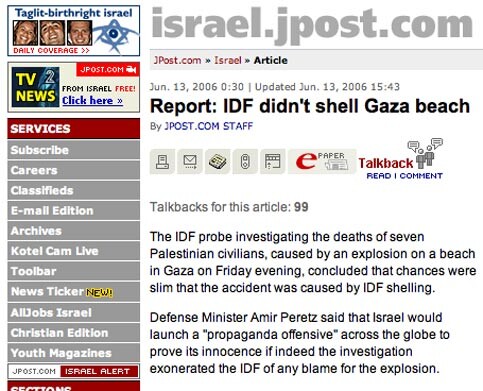
The article linked from the Israeli Foreign Ministry’s website.
Today, we saw the full power of Olmert’s lie, as another Israeli attack was carried out in Gaza in broad daylight. Witnesses reported that an Israeli aircraft fired a missile at a van on a busy highway. Civilians ran to help the passengers, two members of Islamic Jihad, and the aircraft fired a second missile into the crowd.

Palestinian medics examine a child wounded in an Israeli air strike at a car carrying militants in the northern Gaza June 13, 2006. A total of ten people, including two children and two militants, were killed in the air strike. (MaanImages/Thaeer al-Hassany)
Assassinations carried out with heavy weapons in heavily populated areas are nothing new. From the beginning of the Intifada, until 1 May 2006, 552 Palestinians have been killed in Israeli assassinations. Of this number 181, or a third of the total, were innocent bystanders near the assassination target or simply people that ran to help and were killed when additional missiles were fired. (Source: PCHR).
Israeli occupation forces have killed over 3,000 Palestinian civilians since the Intifada began. Israel’s contempt for Palestinian life stretches from the privates in its occupying army to its prime minister. Israel kills Palestinian civilians not only intentionally but also routinely, and this has been true for decades. The patterns speak for themselves.
Related Links
Nigel Parry is one of the founders of the Electronic Intifada. Based in New York, he offers communications solutions “for clients with something to say”, through his business, nigelparry.net.
